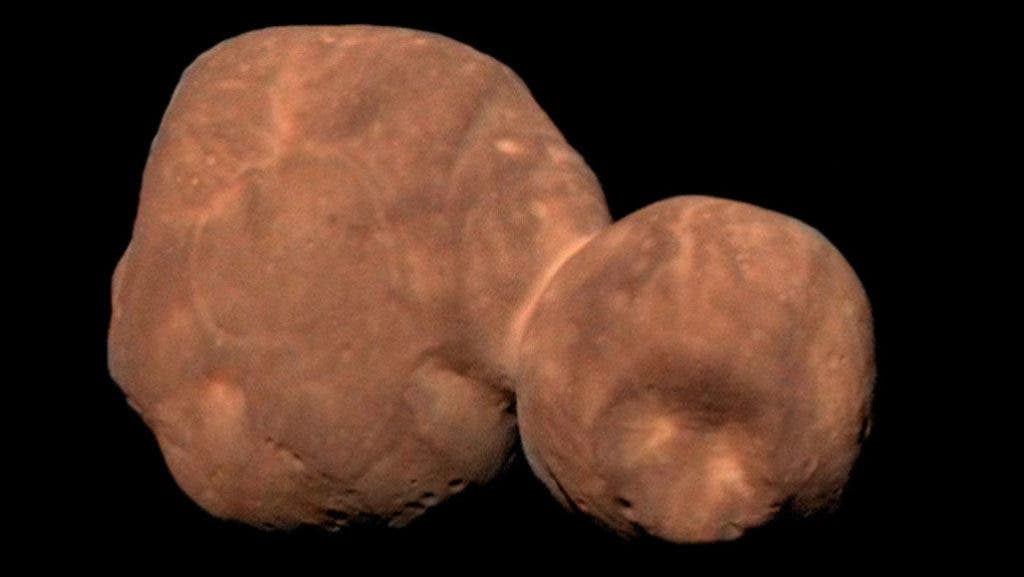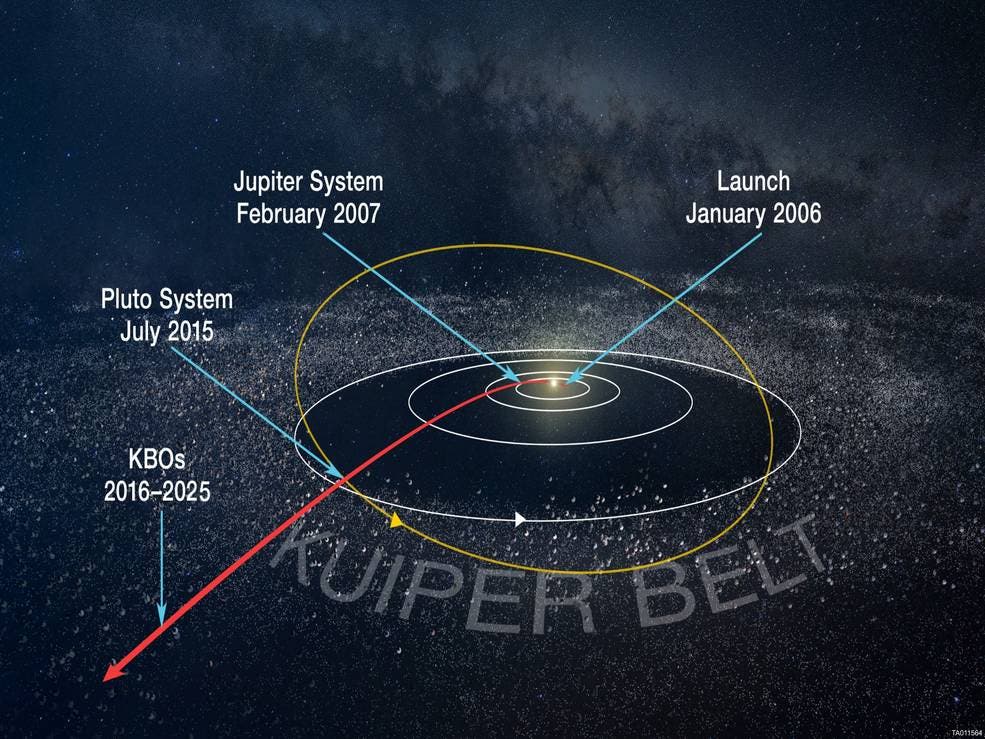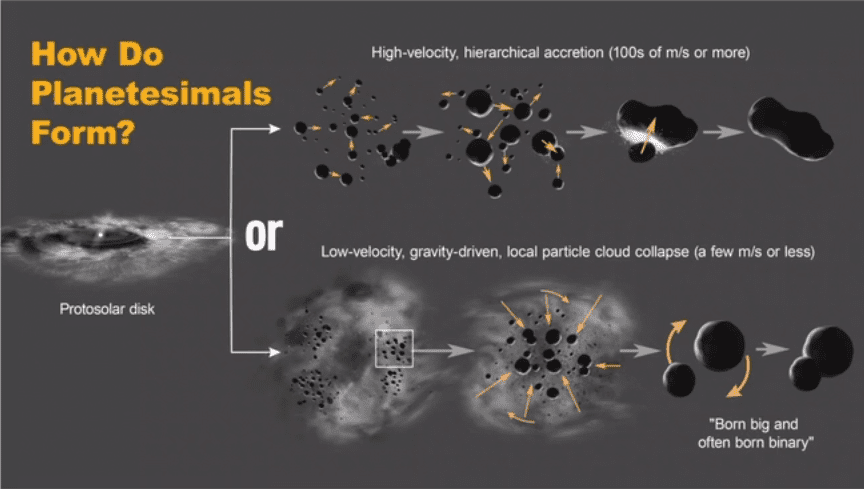
Located beyond the orbit of Neptune and within the Kuiper Belt — a massive circumstellar disc of small remnants left over from the formation of the solar system — Arrokoth (previously known as ‘Ultima Thule’) represents the most distant and primitive object ever to visited by a man-made space probe.
Revealed in a small amount of data collected during a January 2019 flyby conducted by the New Horizons probe, the double-lobed contact binary— or Kuiper Belt object 2014 MU69 to give it its formal name — is the subject of three new papers due to be published in the journal Science. The key findings of these studies were revealed at a press briefing held in Seattle, Washington, on 13th February 2020.
The research provides us with a stunningly detailed picture of the compact binary’s composition and origins and suggests a rethink of how planetary building blocks–planetesimals form.
“Data from Arrokoth has given us clues about the formation of planets and our cosmic origins,” says Marc Buie, of the Southwest Research Institute, who was part of the New Horizons team that first discovered the object. “We believe this ancient body, composed of two distinct lobes that merged into one entity, may harbour answers that contribute to our understanding of the origin of life on Earth.”

The authors believe that their results could help rule out a hierarchical formation model of planetesimal formation, in which objects from different areas of the nebula of gas and dust violently collide to create larger bodies.
The shape of Arrokoth, with its two distinctive lobes, seems to favour a much more delicate formation process, that of local cloud collapse. This would involve regions of the nebula collapsing with smaller particles gradually accumulating together.
If planetesimals form differently then previously modelled, the fact that they are the building blocks of the planets means that we may also have to revise our ideas of how the planets themselves form.
As the planetesimal is composed of pure and unchanged material, its detailed study could answer long-standing questions about the elements which were present during the solar system’s planet-formation phase.
“The mission of the New Horizon probe was to explore the solar system’s ‘third zone’,” Alan Stern, the principal investigator of the New Horizons mission says describing the Kuiper Belt where icy planetesimals and dwarf planets lurk. “It is the best-preserved region of the solar system, important for understanding its origins.”
Each of the three separate papers focuses on different aspects of Arrokoth’s formation and composition, offering new insights into planetesimals and the conditions and composition of the early solar system.
Three papers, three lines of evidence pointing to a new paradigm of planetesimal formation
William McKinnon and his team investigated how Arrokoth got its unique binary shape discovering that its two ‘lobes’ were once separate independent bodies.
McKinnon and his team believe that the two separate objects which comprise Arrokoth formed in the same vicinity joined together in a surprisingly gentle process. As hierarchical accretion, is anything but gentle McKinnon and his team think that Arrokoth formed as a result of a local collapse of the nebula.
“They’re just touching, it’s almost as if they’re kissing,” McKinnon, Professor of Earth and Planetary Sciences at the California Institute of Technology about the two lobes of Arrokoth. “There’s no evidence that the merger of these two lobes was violent. There’s no sign of catastrophic disruption.
“The merger speed must have been very low.”

Whilst McKinnon and his team focused on the formation of Arrokoth’s distinctive shape, researchers led by John Spencer were studying that shape in painstaking detail.
Spencer and his colleagues reveal that Arrokoth’s binary lobes are flattened in shape with a greater volume than originally believed. They are also almost perfectly aligned. “This tells us these are not objects that just blundered together,” Spencer “They have orbited each other for a long time, gently drifting together.”
The team have also been able to ascertain details about the surface of the contact binary, describing in their paper a smooth face with only slight cratering. This means that Arrokoth stands out from previously visited bodies within the solar system, having been struck by very few other objects. The greater consequence is that Arrokoth’s composition is unpolluted and thus may represent our best chance of studying the building blocks of the solar system.
Other comets that form closer to the Sun evolve very quickly as a result of the intense environments they find themselves in. In comparison, planetesimals that form far away from the Sun remain relatively unchanged, in Arrokoth’s case, for 4 billion years.
Will Grundy and the research team he worked with were charged with investigating the composition, colour, and temperature of Arrokoth’s surface. They found that the planetesimal’s distinctive and uniform red hue is a result of the presence of unidentified complex organic molecules — molecules formed from carbon, nitrogen, oxygen amongst other elements–present with methanol ice.
Grundy’s paper puts forward several suggestions as to how this frozen methanol could have formed on the Kuiper Belt object, including formation by irradiation of mixed water and methane ice by cosmic rays. The team was unable to detect the presence of water on Arrokoth, but they believe it could yet be present, currently ‘masked’ or hidden from view.
The uniformity of the compact binary’s surface colour and composition provide the third line of evidence in support of the theory that it formed as a result of local nebula collapse.
Stern does not downplay the significance of this evidence supporting a new paradigm of planetesimal formation–local cloud collapse. Comparing it to the discovery of the Cosmic Background Radiation which finally settled competition between different models of the origin of the universe he says: “This is a wonderful scientific present. It is truly a watershed moment.”
Stern concludes that every one of the attributes of Arrokoth observed point towards the cloud collapse model. As for the future, he says that the New Horizons mission has inspired other researchers to revisit another occupant of the Kuiper Belt– the dwarf planet Pluto.
Stern also points out that even though the New Horizons probe has “plenty of gas left in the tank,” the ideal mission would study Pluto for a period of a few years before moving off and investigating other bodies in the Kuiper Belt.
“We’re pretty excited, but it’s going to take a lot of work.”


